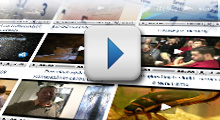Ultraviolet light enables to find white-nose syndrome in bats

4 Jun 2014
The Protest Movements in the Contemporary Middle East

2 Jun 2014
Prof. Noam Chomsky appeared at the Academy of Sciences of the CR

2 Jun 2014
One of the most important scientists of today, Professor Avram Noam Chomsky from Massachusetts Institute of Technology appeared on Monday, 2 June 2014 at the headquarters of the Academy of Sciences of the CR with a lecture “What Can We Understand?” On this occasion, he received from the hands of the President of the ASCR Prof. Jiří Drahoš the honorary medal “De scientia et humanitate optime meritis”. Over the next few days, Prof. Chomsky will attend a linguistics conference organized by the Faculty of Arts of Palacký University in Olomouc and a public debate on current social trends in the Metropol Cinema in Olomouc.
Quantifying the impacts of alien species: towards an IUCN Black List

12 May 2014
One of the major transformations of the planet from human activities is the wholesale redistribution of species, through the deliberate or accidental translocation of their populations to areas outside their native range. These “alien” species have in many cases caused substantial deleterious impacts to the recipient environment (e.g. extinctions of native populations and species, the disruption of soil nutrient and water cycling, and natural disturbance regimes). Preventing and mitigating such impacts is a major drain on limited conservation resources.
The FUNBIO project – studying materials on the boundary of life

7 May 2014
New findings on acute myeloid leukemia from the Institute of Molecular Genetics AS CR

5 May 2014
Physics helps economy: a new monograph on Econophysics from the Institute of Physics, AS CR

12 Mar 2014
Importance and impact of methods and techniques developed for studying physical problems has outreached the realm of natural sciences. Methods of quantum physics and statistical mechanics find more and more applications in biology, economy, informatics, or sociology. Physics has become one of the most important components of a number of new interdisciplinary research fields. Econophysics utilises methods of statistical mechanics and theory of phase transitions to model and understand processes in economy and financial markets.
Brain Awareness Week

10 Mar 2014
Every March, the European Dana Alliance for the Brain (EDAB) coordinates Brain Awareness Week, when hundreds of public events in dozens of countries celebrate progress in brain research and inform the general public about their overall results. In the Czech Republic, Brain Awareness Week activities are organized by the Institute of Experimental Medicine ASCR and by Czech Society of Neuroscience, by the Centre of Neuroscience and by the Centre of Administration and Operations ASCR.
Relativity shakes a magnet

4 Mar 2014
Researchers from Institute of Physics AS CR demonstrate a new principle for magnetic recording
Current technologies for writing, storing, and reading information are either charge-based or spin-based. Semiconductor flash or random access memories are prime examples among the large variety of charge-based devices. They utilize the possibility offered by semiconductors to easily electrically manipulate and detect their electronic charge states representing the “zeros” and “ones”. The downside is that weak perturbations such as impurities, temperature change, or radiation can lead to uncontrolled charge redistributions and, as a consequence, to data loss.
Magnetic inside but not on outside

3 Feb 2014





